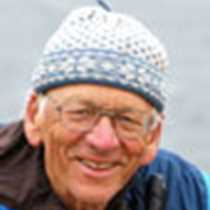Into the Antarctic Convergence
Through sub-Antarctic night we continued on course for the northwestern end of the South Georgia Archipelago. Conditions remained relatively calm with a light wind from the west and an extremely low, wide swell. Many of us woke up, looked outside, and went back to sleep. Thick fog surrounded the ship, so why get up before the official wake-up announcement?
The fog however was an indicator of colder water temps, meaning we were crossing that zone of transition from warmer northern waters to colder Antarctica-originating waters. Staff continued their watchful vigil from the Bridge for marine life, although with limited visibility only a few passing birds were seen.
The weather outside and the calm conditions allowed for perfect opportunities to learn more from the ship’s natural history staff. First of the day was a talk on penguin taxonomy, biology, and behavior by Karen Copeland. Unique to the southern hemisphere, except for one species at the equator, there are about 17 species of these unique birds. Many interesting adaptations are the key to survival for these birds in the cold harsh environments, particularly in the penguins that we will find in Antarctica. With luck we should be able to see six species of penguins on the voyage. Karen provided us with detailed information not only about this group of seabirds but also about the particular species we will see.
Our next presentation was by Jason Kelley with a foundational explanation of plate tectonics. Many were surprised to learn that at one time Antarctica was in the location of Alaska relative to the earth’s axis. Through movement of the continental plates Antarctica arrived at its current southerly location. The Falkland Islands were actually attached to Southern Africa whereas South Georgia was derived from South America. One obvious feature of the landscape in parts of South Georgia is contorted folds of metamorphic rock, which can be seen where ice, snow, and vegetation does now blanket the steep vertical cliffs of some coastal mountains.
After lunch Steve MacLean presented a detailed story of the famous Imperial Trans-Antarctica Expedition of Sir Ernest Shackleton. The story Steve wove is of astonishing proportions. A group of men traveling from England to South Goergia and then attempting to cross Antarctica. The ship Endurance locked in the ice and eventually crushed. Then the crew making their way across the ice to the water and ending up in their boats on one of the most remote islands of the Antarctic Peninsula. Low on food and facing another overwintering, six men took to a small boat to travel back across one of the most weather-stricken bodies of water in the world. Miraculously they made it to South Georgia only to have to hike across glaciers and snowfields to reach habitations at the whaling stations on the northern side of South Georgia. In the end not a man was lost through the entire ordeal lasting over 18 months in late 1914 to 1916.
Late in the afternoon the fog had lifted enough that we passed within sight of a couple rock stacks rising vertically above the wave-lashed bases. Known for the nesting population of blue-eyed or Antarctic shags, Shag Rocks passed slowly by in the distance off the side of the ship. Other seabirds also glided by as our ship continued on course for South Georgia.




